Any recommendations from the experts?
I posted before regarding some bookshelf speakers that just needed betrer positioning.
Newer setup I just finished...
Will be upgrading monitoring chain in the future(been saying it for years right).
Finished Basement Area: 22'Lx13'Wx7'10" height
Built a bridge for my studio monitors and receiver for some hifi speakers.
Due to desk height and video monitors, it had to be built a little higher than I wanted.
I like for phantom center to be more in front of me.
Higher tilted monitors, ever so slightly, puts image a little higher...
Not liking it.
Mostly been doing video editing and sound for video lately, but have a couple of song mix projects
I need to do, so prepping area a little better for that.
I could just get a barber type chair with the feet rest, and use that to bring me higher, which is probably what I will do.
Need to be about 6" higher.
May lay 1" flooring in the mixing area.
Anyone here have monitors on an downward or upward angle?
Does it effect your perception?
I am familiar with recommendations of tilted monitors and angles. I just don't like it.
Here are images of the space.
Finished basement. Foundation located at front wall, and right side.
All measurements of KRK's
Old setup with bridge and desk too high

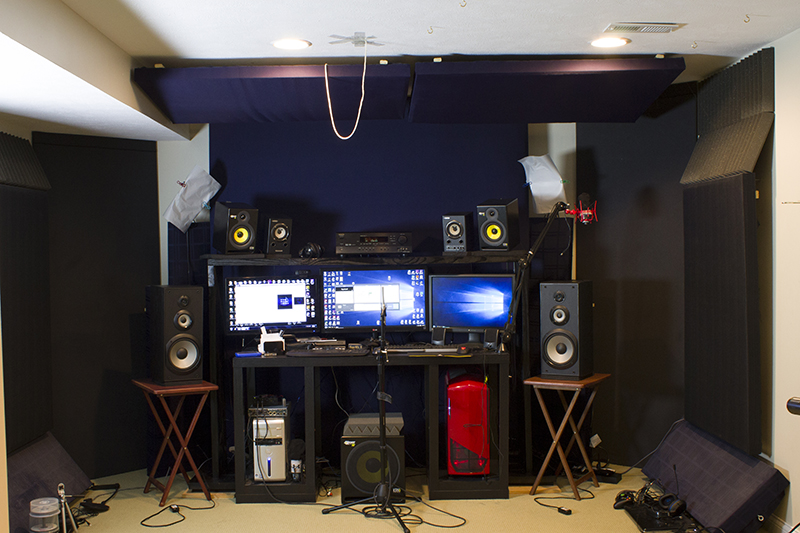
Decided to cut down desk and bridge height

AFTER
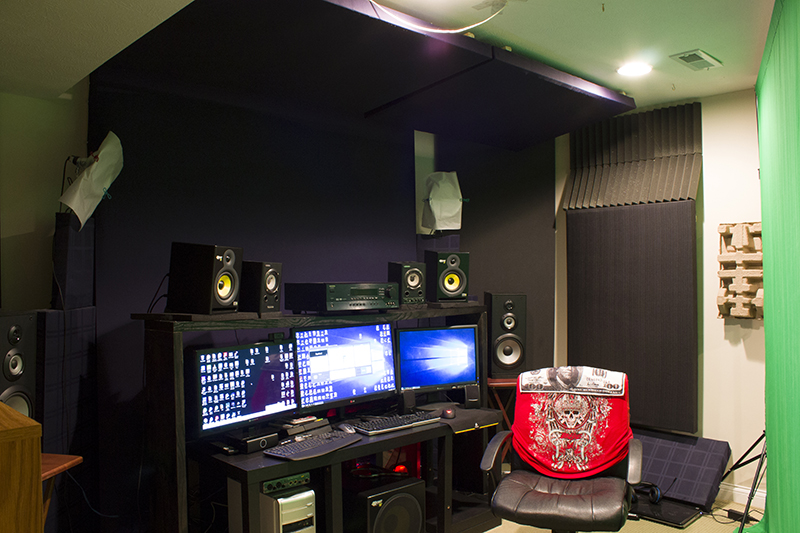
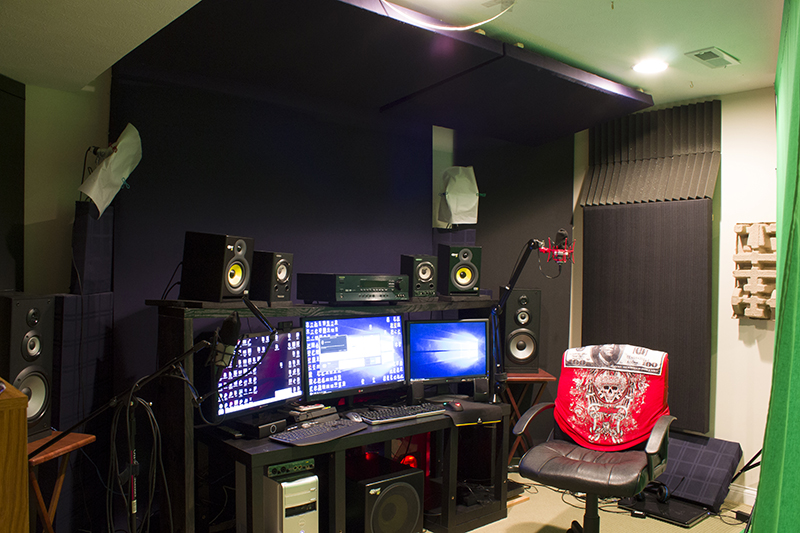
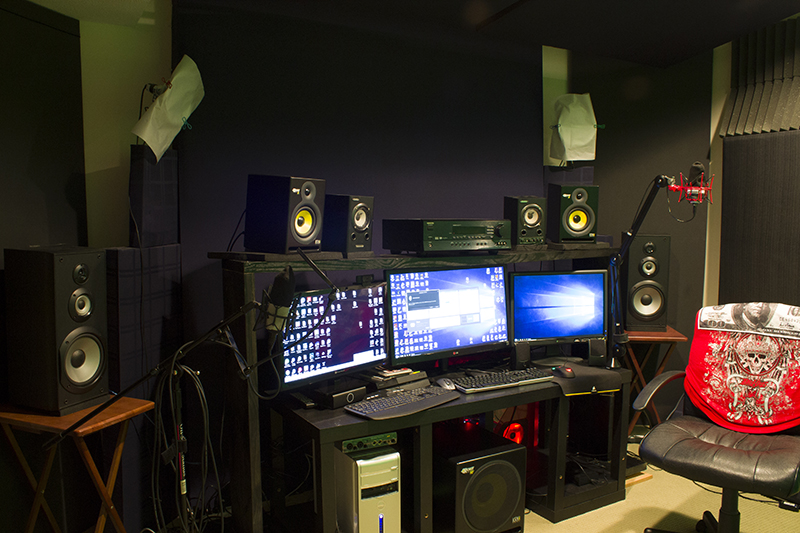
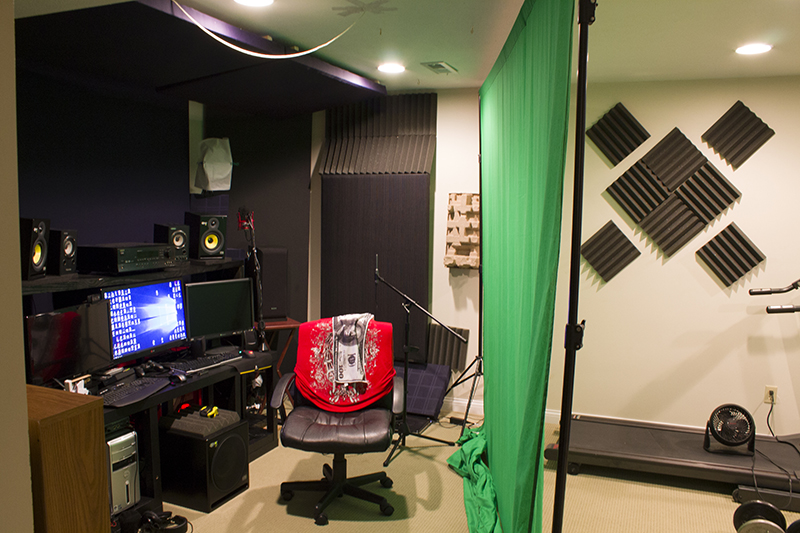
BEHIND ME
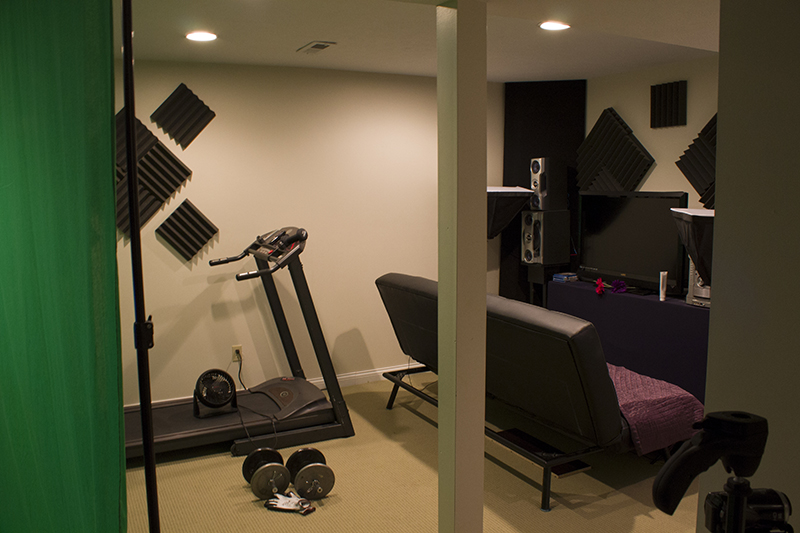
Side Hallway
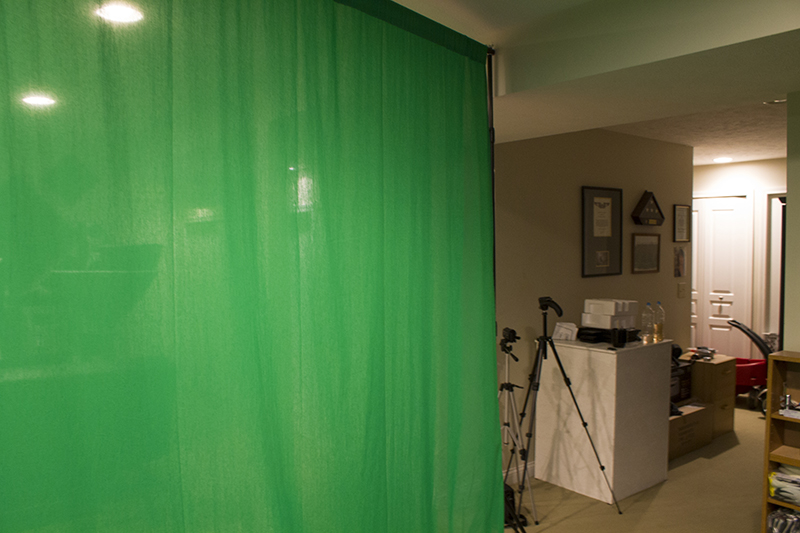
Behind Me/Behind Green Screen
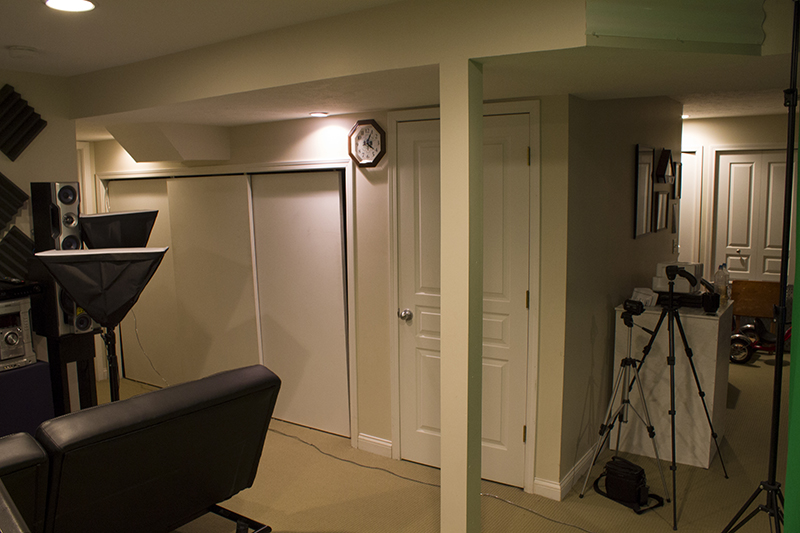
Looking Toward Front Wall
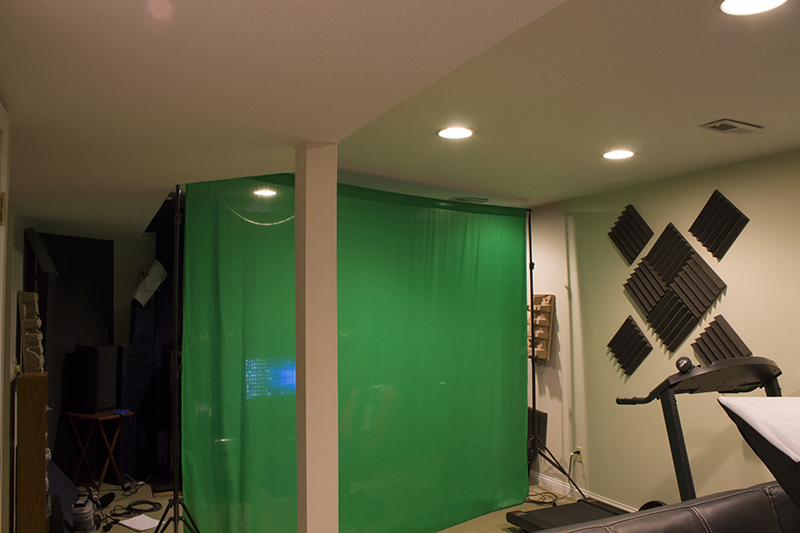
MEASUREMENTS:
Measurement Mic: UMIK-1 with 90degree Serial Number Cal.
All measurements @ 80dB(with equidistant 54" placement)
Monitor Height(between woofer and tweeter)54"
Distance from front wall(back of monitor)12"
Speakers: 2)KRK RP5 First Gen and 1)KRK RP10S Sub
NOISE FLOOR:
Spike at 40hz is fridge upstairs(when running)
Spike at 119hz is computer
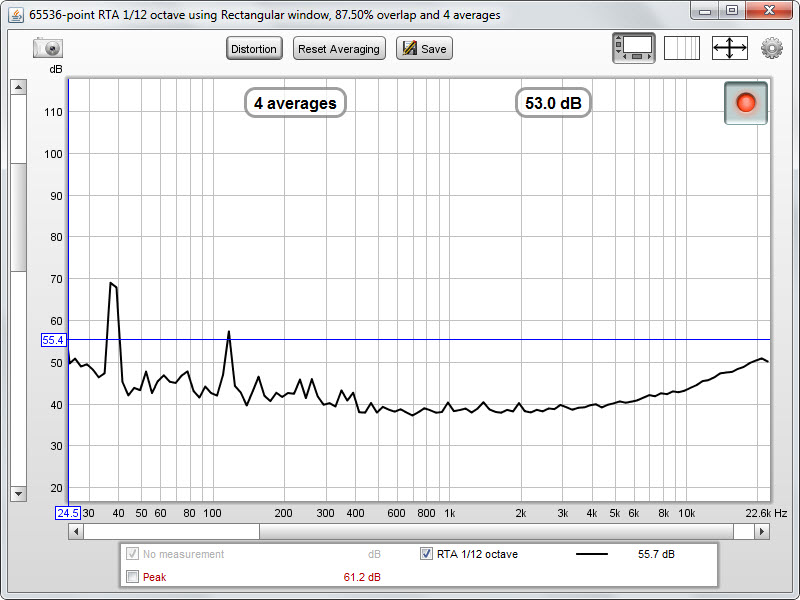
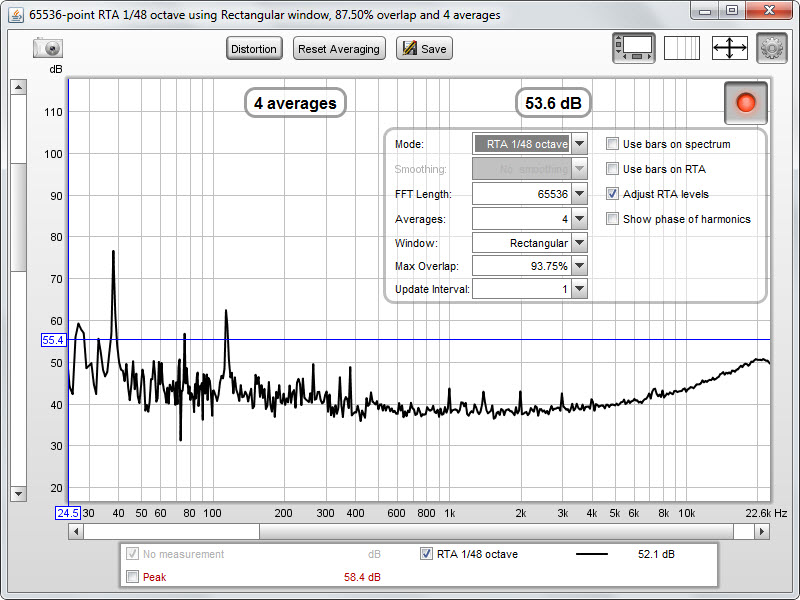
Left Right No Smoothing
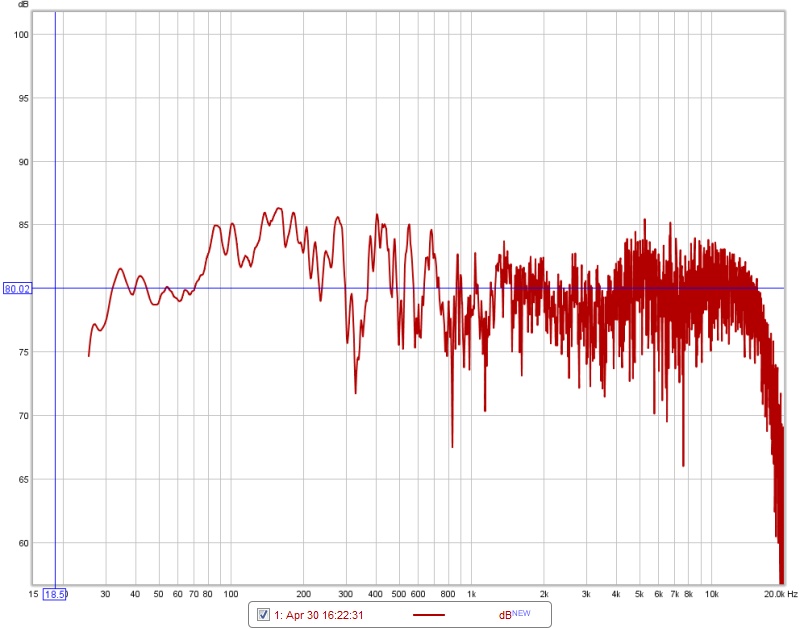
Left Right 1/24 Smoothing

LR Distortion

LR Phase
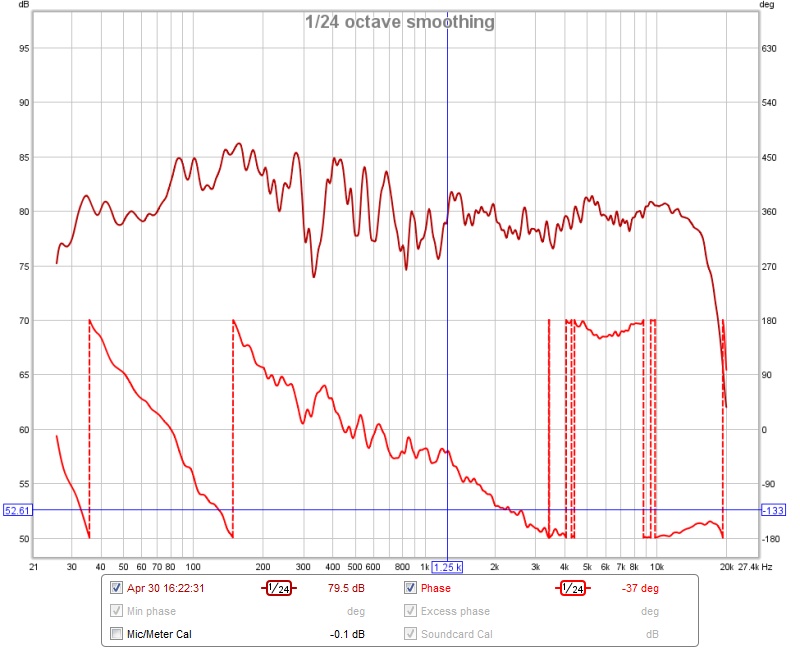
LR RT60

LR Specto

WATERFALL: (With included longer time to see noise
floor constant)
LR Waterfall 20kHz
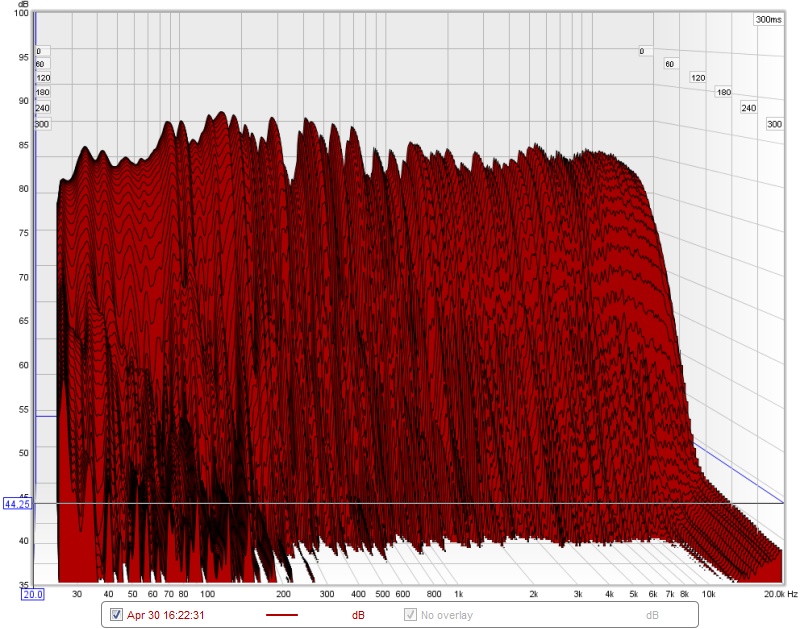

LR Waterfall 500Hz
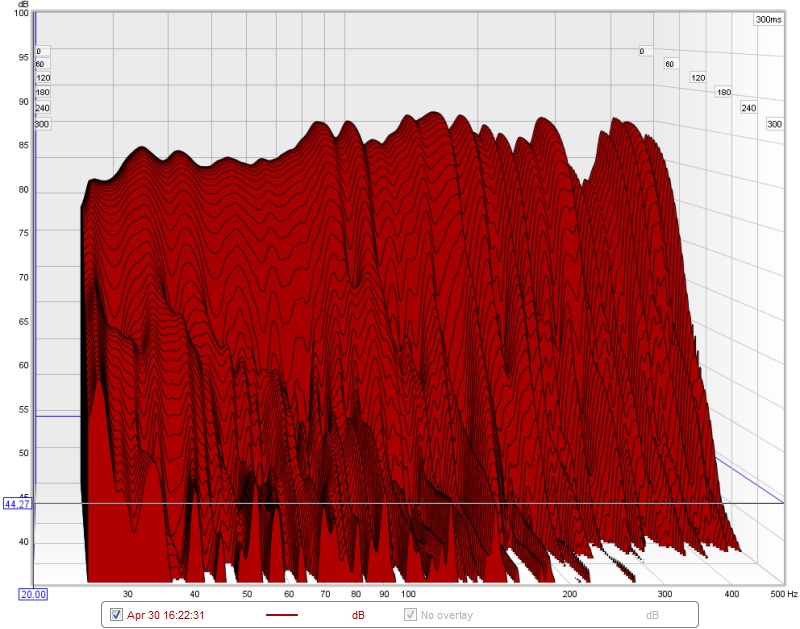
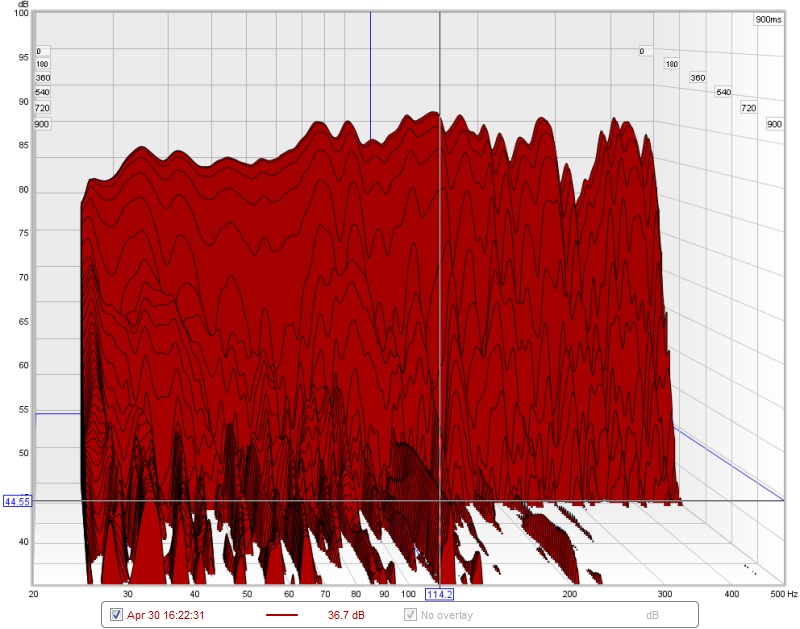
Sub Phase: 0degrees red/180degrees blue

--
LEFT AND RIGHT SEPARATE
LR Overlay

Left IR

Right IR
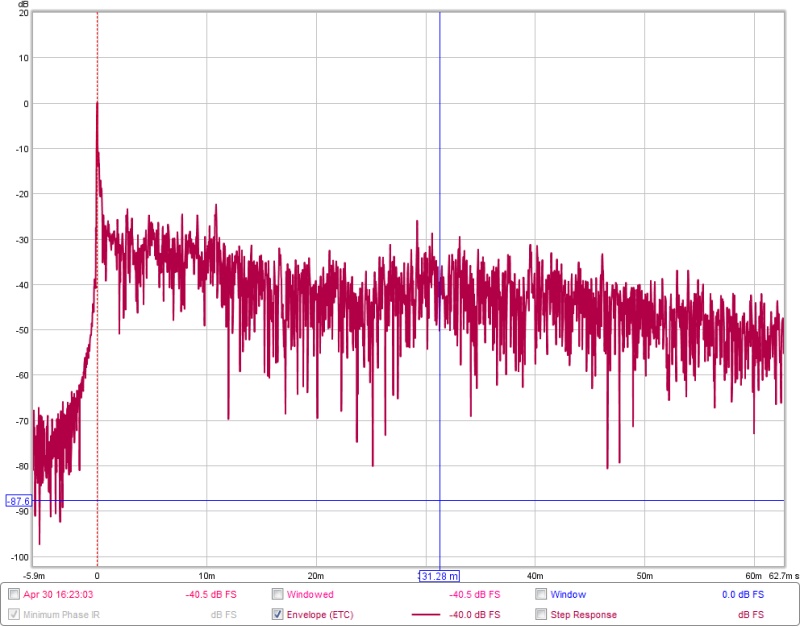
Left FIR
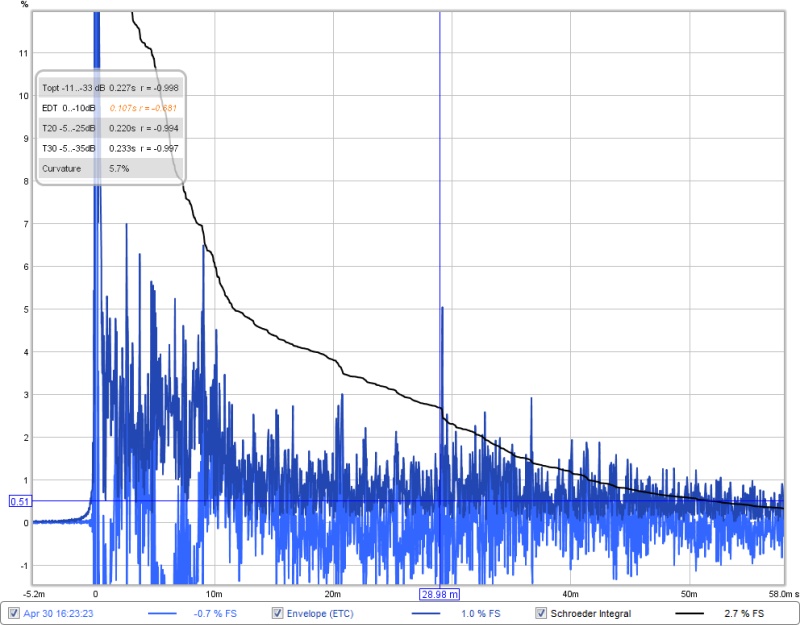
Right FIR
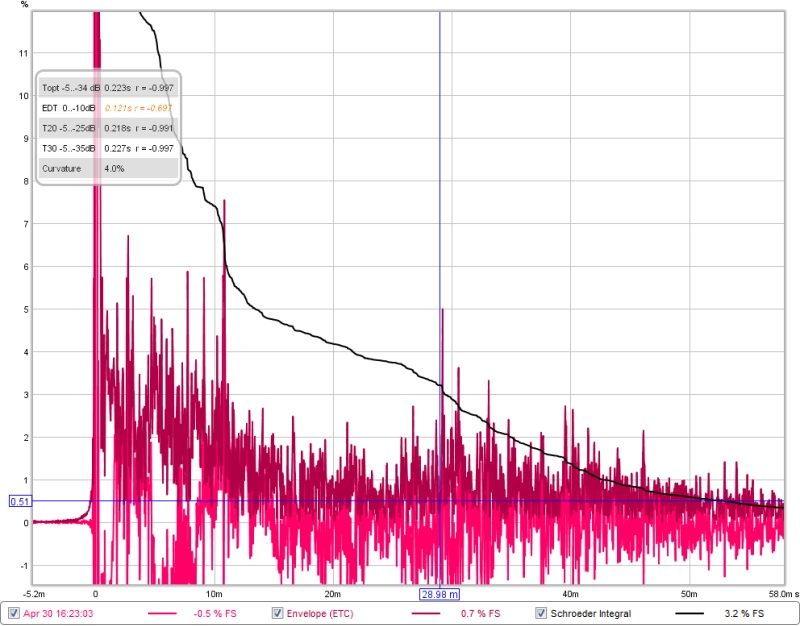
Was considering adding wood flooring to the mixing area..
I do green screen work and photography as well, so that has to stay. For photography I swing
green screen around against right side wall.
I have to have 3 screens for what I do.
The Sony 3-ways are just for listening while in the gym
that is in the back room.
I know your thinking: Why does he have OG Gen1 KRK RP5 monitors.
Well, because that is all I need.
At one point was about to pull the trigger of Barefoot Gen2 MicroMain27 pair for around 10.5k..
but decided not too for now. Maybe in the near future. I really do not need them right now for
a bulk of what I do.
I can provide REW measurement files shortly.

Comments
I am nowhere to be an acoustic expert. But there's a few things
I am nowhere to be an acoustic expert.
But there's a few things that bugs me in your setup.
1 - where do you put your legs with that subwoofer in the way
2 - Those monitor sets seems to be great but they are a placed in a way that each set ask for a different listening position.
3 - is that top shelf supported only by the sides ?? with the monitors and the PA I'd be afraid it may fall off.
The ideal position to listen to a speakers/monitors is to place the same distance from your ears as between them. (forming a perfect triangle with equal sides)
Like it is, how does the room sound when you record in it and how does your mixes sound when you listen to them somewhere else ?
It's always down to what makes you mix better.
Personnaly, there is too much bass in my control room, because I know it takes that to help me mix with less bass. you see, 30years of live sound work give you a taste for too much bass so I needed to compensate for my taste and I know get better results ;)
Hey there. Room acoustics are so important, I applaud you for pu
Hey there. Room acoustics are so important, I applaud you for pushing through the tedium. Here's some thoughts and questions.
Can you describe your testing procedure? Ie How many measurements at each testing location.
It seems that the monitors are still two high. You want the tweeters to 'at or slightly above' ear level. If your tweeters were in the physical location of the dust cap on the krk's woofers, that'd be about as high as you'd want them ideally.
The decay times in your low end need a lot more trapping. There's low frequencies lingering for almost a whole second, compared to the mids/highs which have a fast decay time. This suggests a disproportion in the amount of HF vs LF treatment in the room.
That subwoofer isn't doing you any favors in that reguard.
Just like testing the speakers multiple times from different locations, it's good practice/technique to move the sub woofer around and test were it exhibits the flattest response. Turning it off can reduce a lot of that LF activity happening at the mix spot.
If it were my room, I'd get rid of the bridge on the desk completely. Then just get some cinder blocks and use those as speaker stands. I'd get two sets. One set for the big speakers, then another set w the KRKS and the minis on top. This should help tighten things up a noticeable amount, for little dough.
If the speakers are 3 ft apart, you want to be 3ft away from them. As it stands your working position where you'll be within reach of the keyboard for mix and edit, is way way to close.
Speakers generally perform best right up against the front wall, or about 2-3' minimum away from the front wall, for solid low end coherence.
A residential room that size is plenty capable of decent response, I've used one that size for a few years. I found my 8" woofers finally had the space they needed to breath.
All in all your off to a good start it looks like, just some cheap, simple things can be done to greatly enhance response, via no resonating speaker stands, and optimum placemeant within the room. after that trap trap and trap.
"Spike at 40hz is fridge upstairs(when running) Spike at 119hz i
"Spike at 40hz is fridge upstairs(when running)
Spike at 119hz is computer"
I like the fact that the OP is asking for help but knows all the answers.
I'm getting a sense of deja vu here
I'm getting a sense of deja vu here
I'm a glutton for punishment, and started with an honest and sin
I'm a glutton for punishment, and started with an honest and sincere answer, prepared to be explained to by the OP why I'm wrong, and the room is correct. Lol Physics can be defied with enough belief or desire, whether or not it can be witnessed is always the question. I will reserve judgement for the sake of peace and equality.
Brien Holcombe, post: 438258, member: 48996 wrote: "Spike at 40h
Just letting you guys know just in case.
kmetal, post: 438257, member: 37533 wrote: Hey there. Room acous
Due to focal length of camera lens, it constrains proportions...so the sub will look closer, the bridge higher, in proportion to chair.
It (bridge) will also look higher too.
The screens are sitting on desk with top surface of desk at 20in from ground.
If I put monitors on stands, they would have to be same height to be above screens. Could be a little lower though, if you subtract thickness of bridge plus some.
I have the monitors angled down about 4 degrees or so.
I extend my chair up to get level with the KRK monitors.. The other monitors are mainly for checking mono, and just quick sound for internet.
The midpoint between woofer and tweeter is about 54 inches from ground.
The monitors are 50in apart.
Mix position is around 50in from there.
So equidistant triangle.
In some major mix studios I have been in, where monitors are on bridge...they are sometimes higher than what I am using.
I got a barber chair today, and I only needed to get raise height about 5" more..
Now my monitors are pretty much straight.
I believe the ringing out that remains constant is the actual noise floor.
That is why I also provided the longer time plot for waterfall.
The ones that dont extend the full 900ms most definately are ringing out.
The wifey was upstairs watching a show.
Very very faint. Could have increased noise floor.
I will do a 90dB measurement after I lay down some wood if needed.(better signal to noise ratio)
How about RT60 time?
So far it sounds good. Doing my first mix with the setup either tomorrow or next day. Will see how it translates.
I am thinking RT60 at around 250 may be alright...but may want it a little longer.
I actually moved the sub all around...and came to be that is where it was best. Pulled out like that. Its about a foot from my toes.
The speakers are about 12" from wall.
Going to take some wood flooring from my gym and lay that in mix area.
See how that sounds.
Testing was ear height, center mix position. Equidistant triangl
Testing was ear height, center mix position. Equidistant triangle with string.
90degrees (ceiling) using downloaded calibration file for 90degrees per serial number on mic.
No averaging. Never moved mic.
SPL in REW calibrated at 80dB measure level.
Bridge made of 2x12...with braces.
I can sit on it. Pretty sturdy.
kmetal, post: 438262, member: 37533 wrote: I'm a glutton for pun
Nah it's cool. I will take everything into consideration, and explain things further if needed.
Sean G, post: 438261, member: 49362 wrote: I'm getting a sense o
Right...lol..
It's all good.
Unless this is the matrix...and your the keymaster. (my poor attempt at Matrix movie humor)
Dejavu was a signal glitch that Sentinels were nearby....
Personally, if it was my set up I would do away with the bridge
Personally, if it was my set up I would do away with the bridge altogether, wall mount the LCD screens on the back wall about 10 degrees above eye height then put the nearfield monitors in place of the screens on small risers so they are at ear height in an equilateral triangle to the mix position with the amp in the centre.
It would give you more space and your LCD screens would sit just above your nearfield monitors. Wall brackets for your screens are reasonably cheap, or you could shorten the timber from your bridge to accomodate a shelf to sit them on with some smart looking brackets in place... (isn't there some sort of large frame behind that big purple broadband absorber behind the desk from memory ?...you could mount your wall brackets or a shelf to this if the whole thing is fixed to the wall securely).
I did this with my LCD screen (42 inch LCD) and it gets them up and out of the way and gives you more space to play with on the desk and gets your nearfields in the optimum listening / mix position. Ideally you want the distance from each ear to be the same distance as from centre to centre of each speaker cone, with the speakers not so much facing directly at you but going past each ear. Your optimum mix position would be at the third point of the equilateral triangle.
IMO.
Sean G, post: 438269, member: 49362 wrote: Personally, if it was
Great freakin idea.
Yes, speakers are aimed slighly behind head.
AODEF, post: 438264, member: 49773 wrote: I believe the ringing
If you look at 100ms, the +120hz is completely decayed. Below 120hz has peaks as high as 20db above that, and continues to decay unevenly for nearly a second.
I'm guessing your crossover is set to around 100hz, and that your subwoofer is cause the 20+ db swings in your low end response. Eq makes the sweet spot smaller and the nulls worse, so if your using any eq I'd remove it.
You really have to have it quiet for a couple minutes while you take readings if you want anything accurate, and worth anylising. There's no 'wifey filter' on the graph settings.
Rooms that size don't really have an RT60, or shouldn't. RT 30 is a more meaningful measurement but even then, small rooms don't develop reverberant fields, so don't/shouldn't have meaningfully measureable reverb times/trails. That's why your lingering sub octaves are concerning, and need to be tamed, or the sub shut off. There's way too much energy down there.
I'd like to see these measurements, as that's some of the most useful we could check out.
That's really a no mans land. Obviously each room is unique and it comes down to trial and error, but you would probably see better overall response with the speakers pushed directly up against the wall, or pulling them out another foot or two. That's one of the big advantages of having speakers on stands.
This is where we need to do some more work. Typically you would want to see measurements from 6-10 different locations around the area you tested already. If you made a grid of 1' tiles you'd want to measure at points to the sides and rear of the listiening position, in 6"-1' incremets. This will help identify nulls and modes easier. so in general it takes a couple hours and 60-120 measements to get a feel.
It's common to have the speakers aimed at a point about 1-6" directly behind the listening position, in the 'producers position'. If you make an equalateral triangle from that point, it increases the sound stage at the listening spot.
It's important to do 'quasi anechoic' measurements by observing response in certain short time Windows, this shows exactly what your speakers are putting out, and takes the room out of the equation. Then other sweeps and impulse responses will demonstrate what the room itself is doing, and how it's interesting the the speakers actual frequency response.
I think 85db has the flattest hearing response curve on the fletcher Munson chart, you may want to consider doing the measements at that level, instead of 80 or 90.
So far it seems like your off to a good start but either need significantly more bass trapping or to get rid of that subwoofer for good bass response. You can always at least turn the sub off quickly critical reference, then resume its action for fun for effect.
Crossover set for 80hz. I will get another measurement @85dB. Tr
Crossover set for 80hz.
I will get another measurement @85dB.
Try to lower noise floor.
With the noise floor in lower frequency around -45, going to make it difficult
to get a good readout in waterfall.
Especially if I scale graph down to -35.
Those would ring out indefinately because the noisefloor is there.
I will also make sure fridge is not running. Also engage wifey filter manually.
No eq in measurement.
AODEF, post: 438284, member: 49773 wrote: With the noise floor i
My concern isn't an indefinite ring below 45db, it's the disproportionate low end response that exists, while the signal db level works its way down to the noise floor.
Until there's a series of proper measurements done it's going to be tough to do have anything definitive or useful.
It seems that rather than asking for advice and reccomendations from the community, you'd rather just show us what you've got goin on. Which is cool, I love looking at studios. But... If there's going to be disregard for the elephants in your room like the subwoofer, the need for more bass trapping (especially w a sub woofer), speaker distance from front wall to help minimize SBIR, there's not much that can be done. Gotta get the fundemtals correct as they can be then dial in from there.
This is either a true attempt to improve your listening, or a simple 'yes dear your studio looks cool'.
I will attempt to get some better measurements. Room is far fro
I will attempt to get some better measurements.
Room is far from cool....lol.
Plus it's a pretty cheap setup, as far as audio gear. Using this for now though.
I agree...can't reach a goal without getting things in line. Thanks for the help.
Good idea, and while you do that, address why the drop at 10K to
Good idea, and while you do that, address why the drop at 10K to 20K.
Here is the thing, for me, your "testing" amounts to shit.
What is it you want to do and how can we help you?
Drop? Referring to weird thing happening in waterfall with high
Drop? Referring to weird thing happening in waterfall with high frequency ringout(not sure what that is)... or frequency response dropoff?
(isn't it normal especially with 90degree measurement?)
For showing plots, to post online.
Don't I just measure from one location?
I know you can take multiple measurements and average the frequency response.
Goal is just to see recommendations, and go from there. I can provide measurement files once I remeasure.
AODEF, post: 438287, member: 49773 wrote: I agree...can't reach
What is your goal, precisely?
I think that's what Brien was getting at...
Placement/Angle of your speakers isn't going to matter much if your room is acoustically skewed.
Are you asking for treatment suggestions for particular frequency control?
AODEF, post: 438292, member: 49773 wrote: Drop? Referring to wei
This is a good start, which is from one of my previous replies. You want to compare all the measurements to see the variances in the basic listening sweet spot.
A few things AODEF. I haven't seen where you said what type/kin
A few things AODEF.
I haven't seen where you said what type/kind of microphone you are using. Oh, forgive my curt post last night, I was drinking old whiskey and playing poker on a losing night. But even when you do or if you are using an appropriate mic, whatever you are looking for in this will never give you anything of any value.
Let me preach on it.
When you test a room...you are attempting to ascertain what it is inside of these hard boundaries that is useful, what is irrelevant and knowing that, how to modulate or correct the accentuation or deficiency. The key words are "hard boundaries".
In your mind you see a small piece of floor and in your mind you have erected "boundaries" to section off this mix environment from the rest of the area. But the microphone doesn't see that. Sound is like water being poured into a container. Consider if you had an aquarium shaped like your existing floor plan, video room, washroom, hallway, et.al. If you poured water into this aquarium it would begin to fill, water would flow around ever corner and into each section with no resistance.
Sound does that.
The things that alter the path are...nothing. Not the hallway, not the sheet, not the anything. So when you attempt to "test" this environment and you think "I can add more treatments to the walls" you will be incorrect because the microphone sees the entire footprint, not what is in your head as "boundaries".
The next time you DO test...take that sheet down as it is interfering with the highs. But, a test is really a waste of valuable time with no rewarding information as your room is currently.
So if you want to test the environment be prepared to fail often because it will be a difficult task when you dismiss the entire cubic space.
Direct to your mixing area:
http://buildthisroom.com/acoustic-treatment-solutions-mixing-room/
You have all the right pieces but they are in the incorrect places. The overhead cloud should be...over >your head not over the speakers. The sidewall treatments should be in line with >your head not just stuck on the wall. Whatever that thing is directly on the wall behind the desk is, get rid of it and reduce the size to be the same as your sidewall treatments and install on the center of that wall directly in front of the listening position.
You have a Berber type carpet so it is affecting your highs selectively...coupled with that sheet may well be the reason your top end sizzle is burning up. If >your ears do not hear the highs that you think it should, then you may want to either get rid of the carpet in your mix area or lay plywood down, at least one full 4X8 sheet, under your chair to get some back.
Brien Holcombe, post: 438356, member: 48996 wrote: A few things
THANKS FOR THE TIPS!.
Great stuff. Going to be making adjustments around monday/tuesday.
I have extra 4x8 sheets in my shed.
This is what is on the front wall. I can easily remove the fabric covering it and modify it.
Heck, that would even give me extra materials to do something else with.
The R30 is behind the Roxul Safe-n-Sound